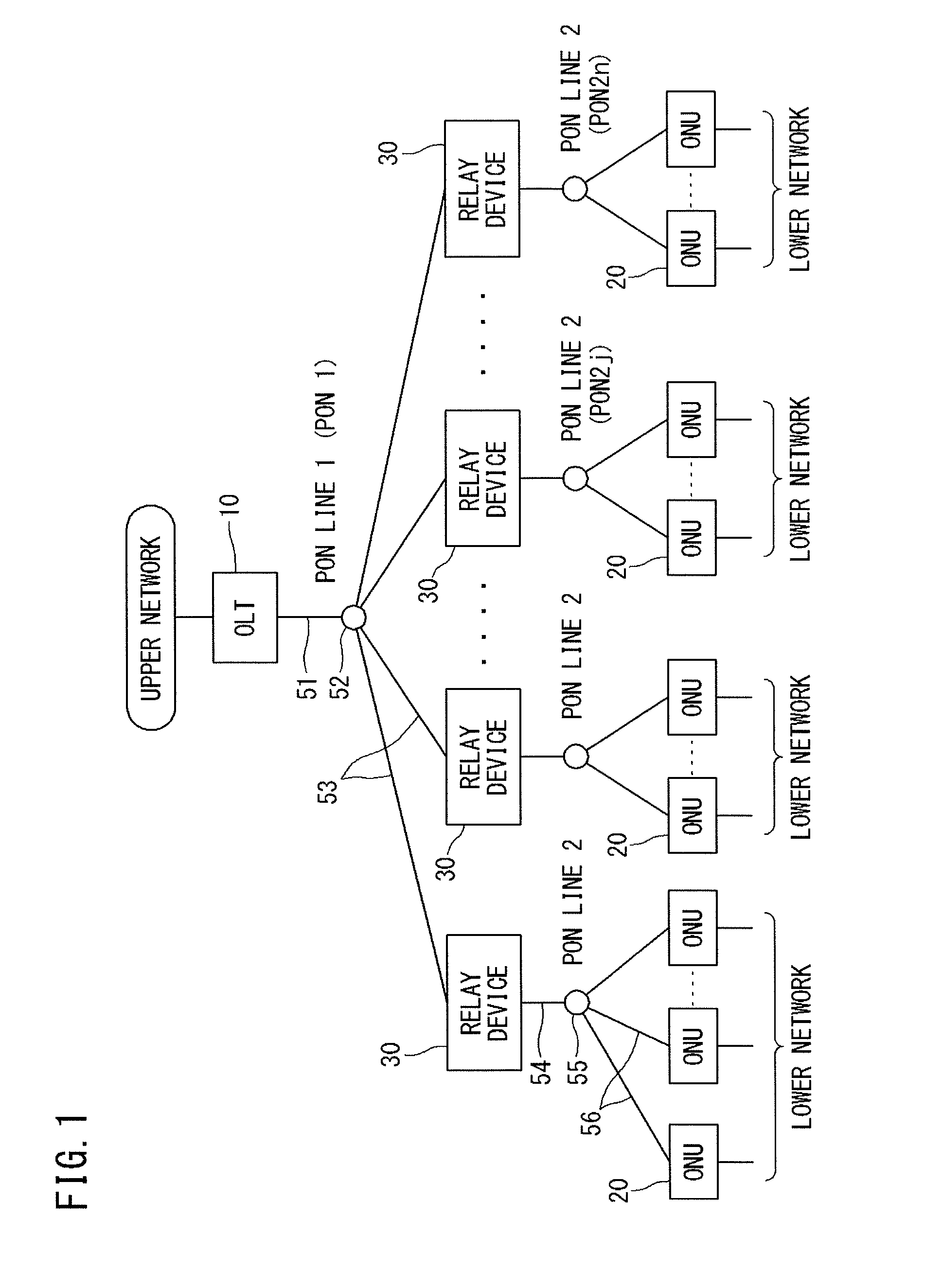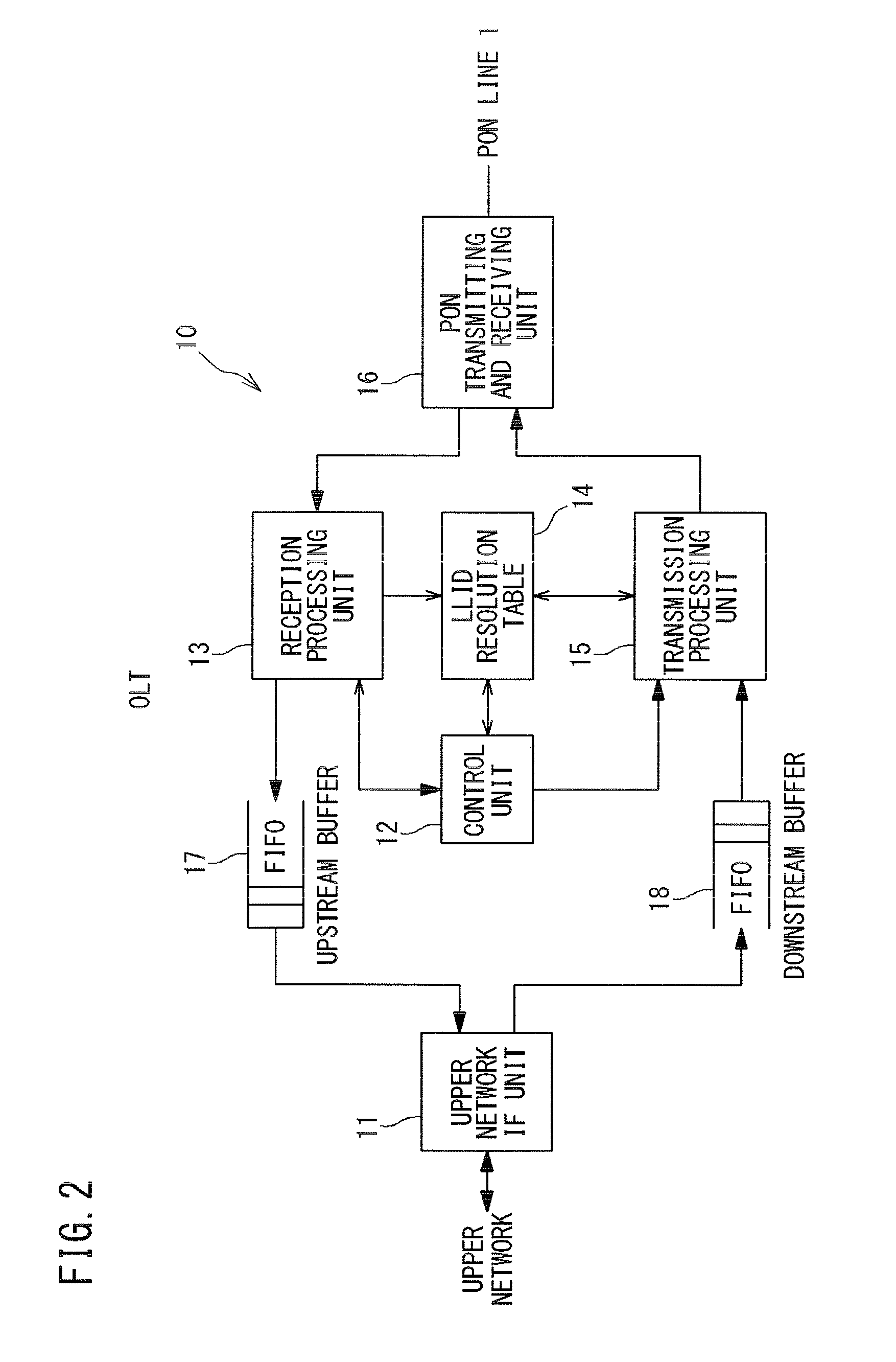Relay device, relay method, and optical communication system which uses relay device
a relay device and relay technology, applied in multiplex communication, data switching details, high-level techniques, etc., can solve problems such as poor signal quality, and achieve the effects of extending transmission distance, ensuring bandwidth per user, and increasing the number of splits
- Summary
- Abstract
- Description
- Claims
- Application Information
AI Technical Summary
Benefits of technology
Problems solved by technology
Method used
Image
Examples
first embodiment
[0092][Connection mode of an optical communication system]
[0093]FIG. 1 is a diagram showing a connection mode of an optical communication system according to a first embodiment of the present invention.
[0094]As shown in FIG. 1, the optical communication system of the present embodiment has a connection mode (topology) in which one station side device 10 and multiple home side devices 20 are connected to each other with a plurality of relay devices 30 therebetween serving as intermediaries and by PON lines 1 and 2 at upper and lower levels.
[0095]Specifically, the one station side device 10 is connected to the plurality of relay devices 30 under the control thereof by optical fibers in a P2MP manner. Each relay device 30 is connected to a plurality of home side devices 20 under the control thereof by optical fibers in a P2MP manner.
[0096]More specifically, a single-core optical fiber 51 connected to the station side device 10 is split into a plurality of single-core optical fibers 53 ...
second embodiment
[0212][Device configuration, etc., of the second embodiment]
[0213]The configurations of an optical communication system, an OLT 10, and ONUs 20 according to a second embodiment of the present invention are the same as those in the case of the first embodiment (see FIGS. 1 to 3).
[0214]Meanwhile, a relay device 30 used in the second embodiment acts as a plurality of “logical ONUs” with respect to an upper-level PON 1. The logical ONUs are provided so as to have a one-to-one correspondence with ONUs 20 in a lower-level PON 2j (j=1, 2 . . . n).
[0215]The basic components of the relay device 30 are the same as those in the case of the first embodiment (FIG. 4). However, in the second embodiment, a second upstream buffer 40 for upstream user frames is provided for each logical ONU in the upper-level PON.
[0216]Upon relaying an upstream user frame, the relay device 30 of the second embodiment uniquely determines an LLID to be used in the PON 1 which is a relay destination, from an LLID used ...
third embodiment
[0280][Device configuration, etc., of the third embodiment]
[0281]The configurations of an optical communication system, an OLT 10, ONUs 20, and relay devices 30 according to a third embodiment of the present invention are the same as those in the case of the first embodiment (see FIGS. 1 to 4).
[0282]In addition, a registration sequence, a multiple access sequence, and a removal sequence are the same as those in the case of the first embodiment (see FIGS. 5 and 6).
[0283]However, in the third embodiment, a PON transmitting and receiving unit 21 of an ONU 20 (see FIG. 3) has a “sleep function” that stops an upstream transmission function. If a sleep signal inputted from a control unit 24 is enabled, the PON transmitting and receiving unit 21 stops a transmission function by turning off the power to its laser diode and transmitter circuit, thereby reducing power consumption.
[0284]Likewise, a transmission processing unit 22 of the ONU 20 (see FIG. 3) also has a “sleep function”. If a sle...
PUM
 Login to View More
Login to View More Abstract
Description
Claims
Application Information
 Login to View More
Login to View More - R&D
- Intellectual Property
- Life Sciences
- Materials
- Tech Scout
- Unparalleled Data Quality
- Higher Quality Content
- 60% Fewer Hallucinations
Browse by: Latest US Patents, China's latest patents, Technical Efficacy Thesaurus, Application Domain, Technology Topic, Popular Technical Reports.
© 2025 PatSnap. All rights reserved.Legal|Privacy policy|Modern Slavery Act Transparency Statement|Sitemap|About US| Contact US: help@patsnap.com



